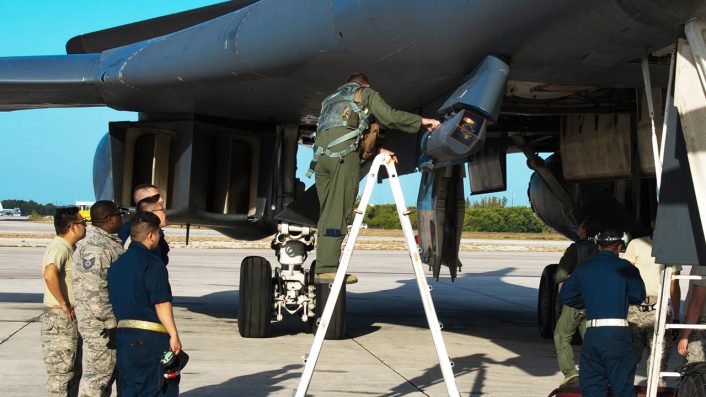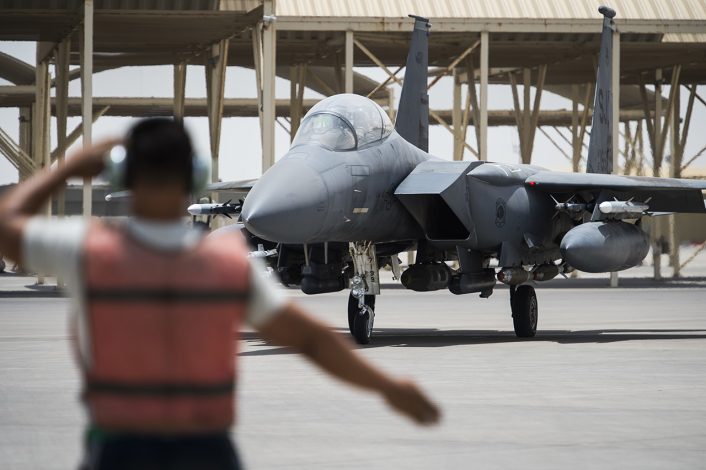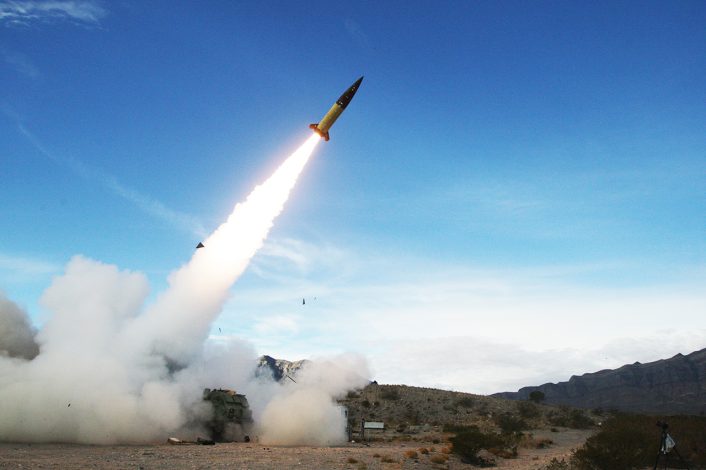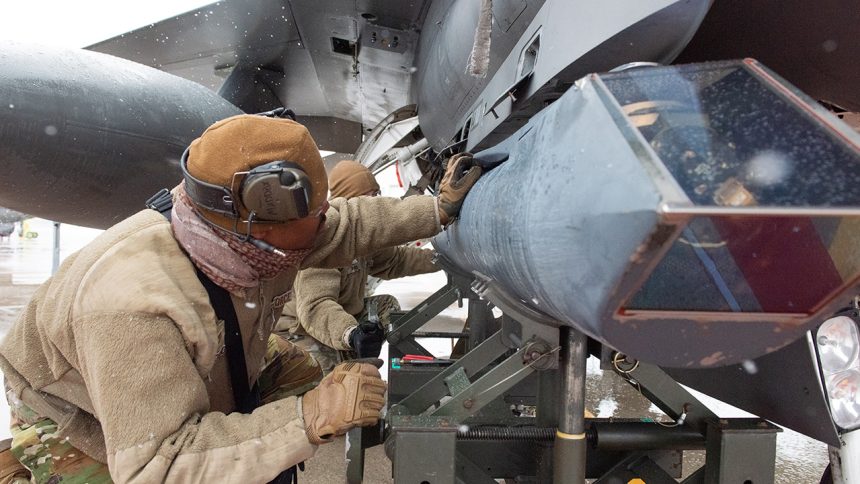Lockheed Martin’s Sniper Advanced Targeting Pod, a mainstay on fourth generation combat aircraft, will be developed into the Sniper Networked Targeting Pod, adding advanced datalink capabilities compatible with fifth generation fighters like the F-35.
It is uncommon today to see images of fourth generation fighter aircraft like the F-16 Fighting Falcon, F-15 Eagle or Eurofighter Typhoon conducting operational missions without some type of targeting pod fitted to one of the aircraft’s hardpoints. With nearly all modern air-launched weapons being precision guided munitions (PGMs), these pods are necessary to enable real-time targeting from the cockpit. They can also provide aircraft with an organic reconnaissance capability, which previously might have necessitated the deployment of specialised reconnaissance platforms.
A variety of different types of targeting pods are in use across NATO air forces, such as the LITENING, ATFLIR, Damocles and the Sniper Advanced Targeting Pod (ATP). The Sniper pod is a prolific platform, seeing use by air forces across the world on many different aircraft types. In U.S. Air Force service, the pod is a common fit on F-15E Strike Eagles, F-16 Fighting Falcons and A-10 Thunderbolt IIs, as well as on B-52H Stratofortress and B-1B Lancer strategic bombers.

With the introduction of stealth aircraft, this proven method of simply attaching the required targeting pods on external hardpoints has become problematic. Any stores attached to the outside of aircraft like the F-22 Raptor or F-35 Lightning II will interfere with the aircraft’s radar cross-section and undo years of work spent making them as invisible to radar as possible. On the F-35, with ground attack and strike capability being a priority during its development, a solution was found by integrating a Sniper based targeting system into the aircraft’s fuselage, becoming the Electro-Optical Targeting System or EOTS.
But with many air forces looking to operate a mixed fleet of fourth and fifth generation fighter aircraft for many years to come, external targeting pods are still the focus for significant amounts of development.
At Farnborough International Airshow on July 23, 2024, Lockheed Martin unveiled their proposal to develop the existing Sniper ATP design into the Sniper Networked Targeting Pod. This pod would combine the Sniper’s current targeting and reconnaissance capabilities with a networking capability allowing advanced secure datalinking between not only fourth generation and fifth generation aircraft but also with ground forces, such as HIMARS and M270 MLRS.
This will bring at least some of the F-35’s much touted networking capabilities to other platforms, enabling mixed aircraft formations without compromising interoperability. One group of F-35s, for example, could act as a penetrating, stealthy first wave in a potential conflict, locating and targeting hostile threats and immediately sharing this data to a second wave of F-15s and F-16s carrying the new Sniper pods and a heavy weapons payload.

The pod will be designed to interface with Lockheed Martin’s newly announced Mako hypersonic missile, which it claims could be carried externally by F-15s, F-16s, F-35s, F/A-18s and P-8s, and internally on the F-22 and F-35C. Such a missile would add even more potency to mixed formations. External carry on the F-35A and F-35B would require these aircraft to forgo their missiles for full stealth capability, but with every aircraft and weapon networked together, these stealth aircraft spearheading an attack could guide the long range missiles launched from beyond enemy radar range by other aircraft.
Lockheed Martin are also keen to point out the proposed new pod’s ability to link with its lines of multiple launch rocket system ground vehicles, namely the M142 HIMARS and M270 MLRS. These vehicles, particularly the HIMARS, have become almost household names following extensive use by Ukraine against Russian forces. Aircraft carrying the new Sniper pod could scout for and target enemy forces, sending this data immediately to a nearby HIMARS or MLRS unit who could then engage with their guided rockets or even ATACMS tactical ballistic missiles.

The Soldiers, from the 3rd Battalion, 321st Field Artillery Regiment of the 18th Field Artillery Brigade out of Fort Bragg NC, visited the New Mexico range to conduct reliability tests of early versions of the Army Tactical Missile System.
Orders for HIMARS by NATO countries and allies have increased dramatically since their famed use in Ukraine, including a large purchase of 486 vehicles by Poland. As a current operator of both the F-16 and the Sniper ATP, and future operator of the F-35, Poland will likely be high on the list of countries desiring Lockheed Martin’s new Sniper development.
F-22 – The Odd One Out
Bringing fourth generation fighters into the fold of future battlefields continues to be a key focus of U.S. technological development. While the U.S. Air Force’s F-15s and F-16s will likely be the prime customer for the Sniper Networked Targeting Pod, the U.S. Navy has also been busy ensuring its F/A-18E/F Super Hornets are also ready for future conflicts. The jointly developed Rafael/Northrop Grumman LITENING pod has been selected to replace the ATFLIR targeting pod on the Super Hornet fleet while Lockheed Martin is developing IRST21 to provide the type with an infrared search and track (IRST) system.
Meanwhile, the U.S. Air Force’s premier air superiority fighter, the F-22 Raptor, still lacks a publicly acknowledged organic targeting capability, being the only fighter currently in the active inventory without this function. As a stealth aircraft, the use of existing targeting pods would negate the aircraft’s low radar cross-section, but as an existing, and out of production, design, it is difficult to integrate any form of internal system like the F-35’s EOTS. This means the F-22 cannot self-designate targets for air to surface weapons.
While one could argue that this capability is not as important for a fighter designed primarily for air superiority, the F-22 has seen several deployments to the CENTCOM area of responsibility where they have been used as strike aircraft, using GPS-guided bombs which were presumably pre-programmed before flight. Additionally, we know from footage captured during U.S. intercepts of Russian aircraft that F-16s tasked with U.S. air defence can carry Sniper pods during these missions. Sniper pods were also seen on F-16s launched to investigate and later shoot down unidentified objects over North America in 2023. So it would appear that these targeting systems do have utility in air to air confrontations.
A targeting capability may be part of the ‘stealth pods’ concept that has been seen in development for the F-22.
N33TR, a Rockwell Sabreliner 65 for Airborne Imaging returns to KJWY/Mid-Way regional Airport as ” AIRBORNE33 ” carrying one of the future F-22 pods.
It was at Nellis AFB testing the pod alongside RATT55/NT-43A, a radar test bed that regularly flies alongside B-2s. pic.twitter.com/kNADnga7H0
— 𝙎𝙍_𝙋𝙡𝙖𝙣𝙚𝙨𝙥𝙤𝙩𝙩𝙚𝙧 (@SR_Planespotter) July 1, 2024
While the F-35’s integrated system is highly beneficial for maintaining its stealth characteristics, it also makes the system far more difficult to upgrade, or tailor for an individual operator’s requirements. While legacy aircraft can simply swap to a newer model of a pod, upgrades to EOTS are offered as part of overall airframe updates. An F-35I development airframe delivered to Israel in 2020 notably had its EOTS apertures blanked out, which could potentially indicate a desire by Israel, who developed the LITENING pod, to fit their own custom system.
We still don’t know which direction the upcoming sixth-generation NGAD and F/A-XX fighter aircraft will take with regards to targeting functionality, although presumably they will feature some sort of integrated capability from new. They may also be designed to employ unmanned aircraft in the ‘loyal wingman’ role as remote sensor pods.









